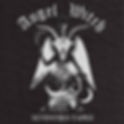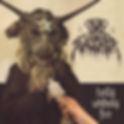Heavy Metal, in most of its sub-genres, is a rebellious brand of music and often the imagery used for band logos and album artwork reflects this mentality. Pentagrams, inverted crosses and such symbols are frequently in use. As Ian Christe, author of Sound of the Beast: The Complete Headbanging History of Heavy Metal says, “Heavy metal design is not a monolithic form at all. You have everything from junior high school kids in Iowa drawing skulls and pentagrams and band logos to Norwegian design houses making skulls and pentagrams and band logos. There are all levels of sophistication and intention—and execution.”
Today I wanted to focus specifically on the image of Baphomet, whom many associate with Satan or Lucifer, which is not the case.
Baphomet and the Knights Templar – The Origins
The first written reference to Baphomet appeared in a letter by French Crusader Anselm of Ribenmont, who was writing during the siege of Antioch during July 1098:
As the next day dawned, they [i.e. the inhabitants of Antioch] called loudly upon Baphometh; and we prayed silently in our hearts to God, then we attacked and forced all of them outside the city walls.
Most probably what Anselm of Ribenmont heared the Antiochians shouting was Muhammad, which he mistook for Baphometh. He was not the only to make the association. Raymond of Aguliers, who chronicled the First Crusade (1096 – 1099), reports that troubadours used the term Bafomet as a substitute for Muhammad and Bafumaria instead of mosque. The troubadour Gavaudan, around 1195, uses the name Bafometz in the Provencal poems Senhors, per los nostres peccatz. Another clear substitution of Bafomet for Muhammad can be found in another Provencal poem, penned by Austorc d’Aorlhac around 1250, lamenting the defeat of the Seventh Crusade (1248-1254). There are other references which I will not be going into.
Baphomet came to the forefront when King Philip IV of France, with the blessing of Pope Clemet V, arrested and put to torture the Knights Templar. It all was coordinated to happen on Friday, October 13th, 1307, giving the day such a dark connotation. Over 100 different charges had been leveled against the Templars including heresy, homosexual relations, degrading the cross and sodomy. The Knights Templars had amassed huge riches since their humble beginnings and some historians are of the opinion that the King of France, greatly in debt, was after their money to finance his battles. The history of the Knights Templar is very interesting, but it would take a shelve of books to scratch the surface.
Under torture one will say anything to make the pain stop. The name Baphomet came up in several confessions obtained from the Knights Templar. The confessors, administering torture, tried their best to obtain information as regards the Templars’ secret initiation ceremony and their alleged worship of a heathen idol-head known as Baphomet. Whilst some Templars denied any knowledge, others described it as a head with three faces or a severed head of a cat. The claim of worshipping and idol under the name of Baphomet were unique to the inquisition of the Knights Templar.
Thomas Wright, in The Worship of the Generative Powers (1856), writes:
“Gauserand de Montpesant, a knight of Provence, said that their superior showed him an idol made in the form of Baffomet; another, named Raymond Rubei, described it as a wooden head, on which the figure of Baphomet was painted, and adds, "that he worshipped it by kissing its feet, and exclaiming, 'Yalla', which was", he says, "Verbum Saracenorum", a word taken from the Saracens. A Templar of Florence declared that, in the secret chapters of the order, one brother said to the other, showing the idol, "Adore this head—this head is your god and your Mahomet."
It might be that the reference to Baphomet in the charges has more to do to apostasy to Islam, than to Satanism, in the case of the Templars. Some of the Templar members were absolved and integrated in other orders, whilst some were not so lucky and burned at the stake. The most prominent being their Grand Master Jacques De Molay and the Preceptor of Normandy Geoffroi de Charney, who recanted their confessions but nevertheless, on insistence of King Philip IV, were put to the flames in Paris on March 1314. This was not the end of the Templars, their legend lives on and until this very day their name is mentioned in many a tale of conspiracy.
The 19th century
During the occult revival of the 19th century, Baphomet came into prominence again during debate on the reasons for the suppression of the Knights Templar. It was common belief amongst Medieval Christians that Muslims were idolatrous and worshipped Muhammad as a god Mammet, a corruption of Mahomet, took the meaning of idol or false god in English).
Within “Symbols and Symbolism”, published as part of Freemasons’ Quarterly Magazine (1854), the anonymous author writes:
“What properly was the sign of the Baffomet, "Figura Baffometi", which was depicted on the breast of the bust representing the Creator, cannot be exactly determined ... I believe it to have been the Pythagorean pentagon (Fünfeck) of health and prosperity: ... It is well known how holy this figure was considered, and that the Gnostics had much in common with the Pythagoreans. From the prayers which the soul shall recite, according to the diagram of the Ophite-worshippers, when they on their return to God are stopped by the Archons, and their purity has to be examined, it appears that these serpent-worshippers believed they must produce a token that they had been clean on earth. I believe that this token was also the holy pentagon, the sign of their initiation (τελειας βαφης μετεος).”
Other scholars who contributed to this debate were Émile Littré (1801–1881) and Hugh J. Schonfield (1901–1988). In 1818, the Viennese Orientalist Joseph Freiherr von Hammer-Purgstall, mentions Baphomet in the elaborate essay "Discovery of the Mystery of Baphomet, by which the Knights Templars, like the Gnostics and Ophites, are convicted of Apostasy, of Idolatry and of moral Impurity, by their own Monuments".
Éliphas Lévi and the image we are familiar with.

Alphonse Louis Constant was born on 8 February 1810 in Paris, France. He was an esotericist, poet and writer. After pursuing an ecclesiastical career in the Catholic Church, he became disillusioned and in his mid-twenties and left the Church to become a ceremonial magician. Aged 40, he began professing a knowledge of the occult and wrote over twenty books on magic, Kabbalah, alchemical studies and occultism under the pen name of Éliphas Lévi, an anagram of his given names Alphonse Louis into Hebrew. I am not going through his life and works as that would require much more space that one would imagine.
Éliphas Lévi is responsible with further associating Baphomet with the occult as in his book Dogme et Rituel de la Haute Magie (Dogma and Rituals of High Magic), published in two volumes (Dogma 1854, Ritual 1856), he included an image, drawn by himself, which he described as Bophomet and “The Sabbatic Goat.” This image became the best known representation of Baphomet. But what did the author himself had to say about the symbolism he was trying to convey?

“The goat on the frontispiece carries the sign of the pentagram on the forehead, with one point at the top, a symbol of light, his two hands forming the sign of occultism, the one pointing up to the white moon of Chesed, the other pointing down to the black one of Geburah. This sign expresses the perfect harmony of mercy with justice. His one arm is female, the other male like the ones of the androgyne of Khunrath, the attributes of which we had to unite with those of our goat because he is one and the same symbol. The flame of intelligence shining between his horns is the magic light of the universal balance, the image of the soul elevated above matter, as the flame, whilst being tied to matter, shines above it. The beast's head expresses the horror of the sinner, whose materially acting, solely responsible part has to bear the punishment exclusively; the soul is insensitive according to its nature and can only suffer when it materializes. The rod standing instead of genitals symbolizes eternal life, the body covered with scales: the water, the semi-circle above it: the atmosphere, the feathers following above: the volatile. Humanity is represented by the two breasts and the androgyne arms of this sphinx of the occult sciences.”
— Éliphas Lévi, Dogme et rituel de la haute magie
Once again, as explained by the author himself, the image has nothing to do with Satanism, yet the Catholic Church gave it that association through its crusade against anything that goes against it’s dogma. Rock and heavy metal received their fair share throughout the years.
Association with witchcraft and the Devil
Lévi believed that what witches were worshipping during their sabbaths during the middle ages, was not the devil, but a perpetuation of ancient pagan rites. Since the dawn of time, male goats were held in reverence by many cultures but this image was morphed to represent the devil or Lucifer by the Catholic Church. Anything pagan or with association to the occult was deemed to be Satanic and thus must be destroyed. The campaigns of the Catholic Church and its associates on pagans, heretics, witches, people of different sexual orientation etc, requires a book of encyclopedic proportions. To be fair, the Catholic Church has distanced itself from such persecutions and admitted the wrongdoings, but some battles are still being fought.
Baphomet and Heavy Metal
Let’s call a spade a spade. There are sub-genres of metal that propagate Satanism but most prominent bands that were accused of having this association are innocent of all charges. Artwork associated with metal records is associated with the shock factor and images related to the occult, monsters and gore are not rare. This does not mean that the band is Satanic. For the sake of this article, I am not focusing on the history of the use of such imagery as album cover artwork, as that would take ages. I have limited myself to choosing a few artworks depicting image of Baphomet or works inspired by this figure. From the middle ages to our time, for different rhymes and reasons, the goat still rules supreme.
Albums


Angel Witch (Apart from adopting Baphomet as part of their logo, they used the image on Flight Nineteen demo) - 1980







References:
Baphomet (Wikipedia)
Knights Templar (Wikipedia)
Thomas Wright, The Worship of the Generative Powers (1856)
Ian Christe, Sound of the Beast: The Complete Headbanging History of Heavy Metal (2004)
Éliphas Lévi (Wikipedia)
